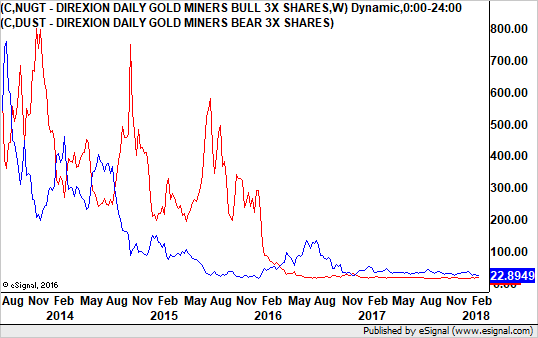Run, Don’t Walk, From Leveraged ETFs
Leveraged ETFs may make exciting moves, but these trading instruments are perilous for most portfolios.

The competition for investor dollars is fierce, and Wall Street is rife with financial geniuses figuring out new products designed to profit from even the most esoteric of trends. Some of them are good. Others could eat you alive.
One truly great idea was the exchange-traded fund (ETF), which allows investors to own a piece of an entire sector of the market, such as banking, the latest hot trend or even the entire market, with one instrument that trades just like a common stock.
Unfortunately, they just cannot leave well enough alone. They have to supercharge it with leverage, which seems to be a way for individual investors to profit with the professionals.

Sign up for Kiplinger’s Free E-Newsletters
Profit and prosper with the best of expert advice on investing, taxes, retirement, personal finance and more - straight to your e-mail.
Profit and prosper with the best of expert advice - straight to your e-mail.
But just because one of their newfangled trading products is exciting does not mean it is right for most investors. Indeed, investors often fail to understand that leveraged ETFs cut both ways. Leverage can rev up your profit potential, but at the same time increase your risk of incurring losses.
Again, that is not necessarily bad. Investors already choose their risk/reward preferences in the types of stocks they buy now. There is a difference between the stock of a staid food company, which makes steady but small profits year after year, and a Silicon Valley company that is working on self-driving cars, cloud computing and blockchain technology. The latter has much higher risk but promises the possibility of a huge reward.
However, leveraged ETFs make big promises they cannot keep simply because of the way they are designed.
Through some financial engineering not relevant here, leveraged ETFs deliver a multiple of the underlying index’s or basket’s returns each day. For example, the ProShares Ultra S&P500 (SSO) “seeks daily investment results, before fees and expenses, which correspond to twice the daily performance of the Standard & Poor’s 500 Index.”
In other words, if the S&P 500 moves higher by 0.50% one day, the Ultra ETF moves higher by 1.00%.
So far, not so bad. If the investor believes that the stock market is going to keep going up then this could be a good vehicle to own. Of course, any day that the market goes down, the Ultra ETF will go down by twice the percentage. That’s the tradeoff for the higher profit potential.
But here is the problem, and it is a big one.
Here Comes the Math
The value of a leveraged ETF is recalculated every day. Let’s say a regular, non-leveraged ETF currently trades at $50.00 per share and a two-times (or 2x) leveraged ETF, based on the same underlying basket, coincidently also trades at $50.00 per share. The next day, the regular ETF falls by one point to $49.00 per share. That’s a 2% loss.
The 2x leveraged ETF falls by 4% to a price of $48.00 per share. No surprise here.
On the second day, the regular ETF rallies back one point to $50.00. Does the 2x leveraged ETF rally back two points? No, it does not. The math says that the regular ETF gained 2.04%. Therefore, the 2x ETF gained 4.08%. Again, that looks good until you realize that a 4.08% gain on an ETF trading at $48.00 results in a price of $49.96. It does not rally back to $50.00, as the regular ETF did.
Why? Because what matters are percentages, not points. To recoup a loss in the stock market, the percentage required to gain is higher than the original percentage lost.
Here is the simplest example. If the S&P 500 loses 50% in a bear market, it must double to get back to breakeven. That is a needed gain of 100%. If it only gains back 50% – the same percentage it lost – it still will be in bear-market territory.
Over time, even if the underlying fund stays in a flat trading range, leveraged ETFs can lose money. That is why they are only for short-term strategies for traders.
The chart below shows idealized paths for a regular ETF, a 2x ETF and a 3x ETF when the underlying simply moves down by one point and then up by one point day after day.

And the same is true for inverse leveraged ETFs, which are designed to move two or three times the daily change in the underlying but in the opposite direction.
Making them even less attractive, the higher the volatility of the underlying market, the worse the capital decay becomes.
To be sure, if you pick a leveraged ETF and the underlying market moves strongly in the direction you wanted then you can indeed make a beefy profit. But even in this scenario, high volatility can still be a huge drag on profitability.
The No-Risk Profit?
There is no such thing as a no-risk profit, but given the natural value decay of leveraged ETFs, selling them short is a good plan, right? If it were that easy, of course, Wall Street would have already figured that out; sell both the leveraged long and inverse versions of an ETF, kick back and watch the profits roll in. That’s the dream anyway and it works sometimes.
A chart of the Direxion Daily Gold Miners Bull 3x Shares ETF (NUGT) and the Direxion Daily Gold Miners Bear 3x ETF (DUST) shows that both ETFs lost plenty of their value over time.

Gold mining stocks saw many short-term up and down cycles over the past few years. Both ETFs lost money.
Now let’s look at an underlying market that was in full rally mode with low volatility. It is no surprise that the Proshares Ultrashort S&P 500 ETF (SDS), a 2x leveraged inverse ETF, plunged in 2017, losing 32.08% of its value. However, the SSO gained 43.72%, which was better than twice the performance of the S&P 500 and its 19.42% gain.
Had you been short each S&P 500 leveraged ETF, you would have gained only 11.68% before commissions. And that does not take into account margin fees and possibly even margin calls.
Before calling your broker to capture what appears to be a risk-free, albeit a relatively modest gain, consider that the 2017 stock market was extraordinarily good to investors, and extraordinarily calm. It was an exception, not the norm.
In most markets, over time, they will decay in value. So even if you feel you missed out on the great rally of 2017, or if you think a bear market is imminent, leveraged ETFs are very likely to burn a hole in your portfolio.
They can be appropriate for experienced traders who already understand the power of leverage and the time-decay factors involved. If you time them right, a quick trade can be lucrative. But most of us should leave them alone. They are not worth the risk.
Get Kiplinger Today newsletter — free
Profit and prosper with the best of Kiplinger's advice on investing, taxes, retirement, personal finance and much more. Delivered daily. Enter your email in the box and click Sign Me Up.

-
 Which Generation Pays the Most Taxes in the US?
Which Generation Pays the Most Taxes in the US?Tax Burden Polls show that most people feel like taxes are unfair. But which age group bears the brunt of the tax burden in the United States?
By Kelley R. Taylor
-
 How Much Will Car Prices Go Up With Tariffs?
How Much Will Car Prices Go Up With Tariffs?Tariffs could drive car prices up even higher, for new and used cars, as well as for American brands.
By Jim Patterson
-
 Stock Market Today: Dow Drops 699 Points After Powell Speech
Stock Market Today: Dow Drops 699 Points After Powell SpeechFed Chair Powell warned of a slowing economy and higher inflation but said the central bank isn't ready to cut rates just yet.
By Karee Venema
-
 Stock Market Today: Stocks Struggle Amid Tariff Uncertainty
Stock Market Today: Stocks Struggle Amid Tariff UncertaintyBoeing dropped after China suspended new aircraft orders, while Bank of America and Citi climbed on earnings beats.
By Karee Venema
-
 Stock Market Today: Stocks Gain on Tech, Auto Tariff Talk
Stock Market Today: Stocks Gain on Tech, Auto Tariff TalkThe Trump administration said late Friday that it will temporarily halt tariffs on some Chinese tech imports.
By Karee Venema
-
 Stock Market Today: Stocks Surge to Close a Volatile Week
Stock Market Today: Stocks Surge to Close a Volatile WeekIt was another day with a week's worth of both news and price action, but it ended on a strongly positive note.
By David Dittman
-
 Stock Market Today: Uncertainty Proliferates: Dow Loses 1,014 Points
Stock Market Today: Uncertainty Proliferates: Dow Loses 1,014 PointsWeaker-than-expected consumer inflation data wasn't enough to stabilize sentiment during another volatile day for financial markets.
By David Dittman
-
 Stock Market Today: Tariff Pause Triggers 3,000-Point Dow Rally
Stock Market Today: Tariff Pause Triggers 3,000-Point Dow RallyThe bond market is sending concerning signals as the Trump administration executes its rapid reordering of global trade relationships.
By David Dittman
-
 Stock Market Today: Tariff Talks Drive Another Up-and-Down Day
Stock Market Today: Tariff Talks Drive Another Up-and-Down DayTrade war negotiations are happening, but the "fear gauge" is gyrating, and investors, traders and speculators are still searching for signs of a bottom.
By David Dittman
-
 Stock Market Today: Trump Pushes Dow Into 2,600-Point Swing
Stock Market Today: Trump Pushes Dow Into 2,600-Point SwingTariffs and trade war weigh on prices across global financial markets, with little light at the end of the tunnel.
By David Dittman